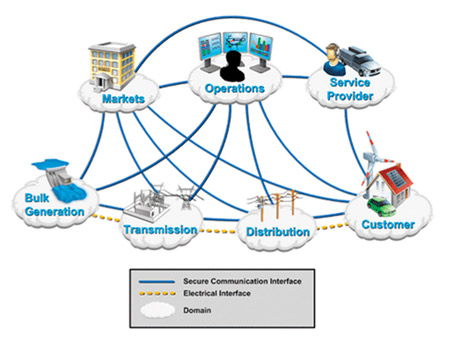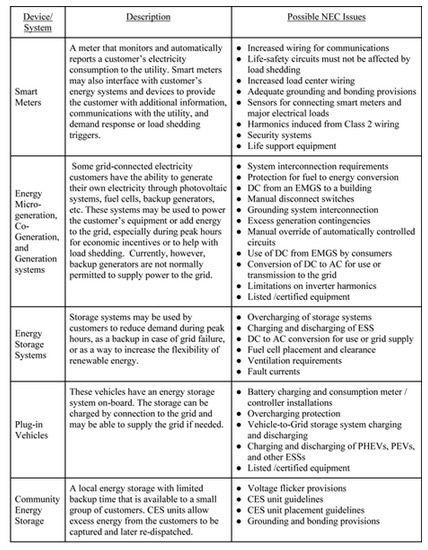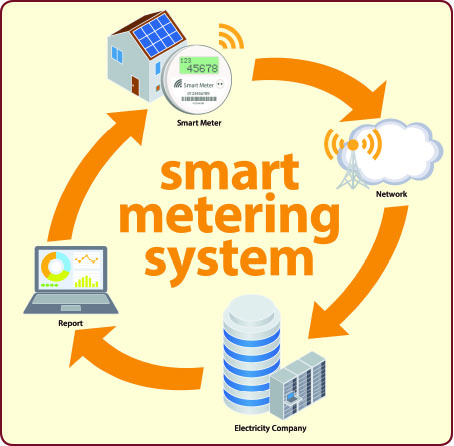Smart Grid Environment
Under the Energy Independence and Security Act of 2007, the National Institute of Standards and Technology has “primary responsibility to coordinate development of a framework that includes protocols and model standards for information management to achieve interoperability of smart grid devices and systems…”1. Furthermore, NIST2 defines the term Smart Grid as:
“a modernization of the electricity delivery system so it monitors, protects and automatically optimizes the operation of its interconnected elements — from the central and distributed generator through the high-voltage transmission network and the distribution system, to industrial users and building automation systems, to energy storage installations and to end-use consumers and their thermostats, electric vehicles, appliances and other household devices.”
In this context, “thermostats, electric vehicles, appliances and other household devices” may be considered “utilization equipment.” The NIST Smart Grid Collaboration Site3lists a wide range of energy management applications and electrical service provider interactions, including:
-
On-site generation
-
Demand response
-
Electrical storage
-
Peak demand management
-
Forward power usage estimation
-
Load shedding capability estimation
-
End load monitoring (sub metering)
-
Power quality of service monitoring
-
Utilization of historical energy consumption data
-
Responsive energy control
A Smart Grid Conceptual Model may be portrayed as a set of diagrams and descriptions that are the basis of discussing the characteristics, uses, behavior, interfaces, requirements and standards of the Smart Grid.4This conceptual model, shown in figure 1, provides a context for analysis of interoperation and standards for the development of the Smart Grid architecture.

Figure 1. Smart Grid Conceptual Model5
Within this model, customers are defined as the end users of electricity; they may also generate, store, and manage the use of energy. Traditionally, three types of customers are identified, each with their own domain: residential (home), commercial (building/commercial), and industrial. In addition, the end user may be an institutional customer (such as schools, hospitals, etc.). This project focused on the end user, or customer, in the built environment as shown in figure 2.
The implementation of the Smart Grid changes the nature of the electrical distribution system in ways that have a number of different safety implications, including personnel safety, electrical safety, and fire safety. Because of these safety implications, it is important that relevant safety codes and standards, such as theNational Electrical Code, stay abreast of Smart Grid developments.
Before the Smart Grid, electrical power distribution to customers was largely a one-way process, with customers receiving electrical power generated at a bulk generation plant which was then transmitted and distributed via the existing grid. Under this scheme, a limited amount of instrumentation data could be transmitted from a customer to the service provider and, in some instances, remote control could be executed.
Under the Smart Grid, electrical power generation and distribution become a two-way process between the customer and the grid. To work effectively and safely, the processes of power generation and distribution, as well as those of instrumentation and control, must be closely coordinated and managed.
Smart Grid Technologies

Figure 2. Smart Grid Customer Domain 6
Current and emerging Smart Grid technologies were reviewed and the implications that these technologies may have upon the built environment (such as a facility’s safety features) were assessed wherever the National Electrical Code (NEC) has jurisdiction. This included all power distribution and control systems throughout a facility. Specific areas of focus were:
-
the electrical service or utility point of connection interface (smart meter);
- energy generation and microgeneration systems (such as photovoltaic cells, wind power, micro hydro, emergency and standby generators, and fuel cells);
-
energy conversion/storage systems (such as batteries, Uninterruptible Power Supplies (UPS), and thermal energy storage);
- plug-in vehicles;
- community energy storage.
Customers who adopt smart grid technology gain control over the amount and time of electrical load consumption. For residential customers, the smart meter will generally be installed by the utility or service provider, and the customer may acquire additional devices/systems to take advantage of the information and communication provided by the meter. For example, if these customers switch to a time of use pricing system, they can benefit by shifting nontime-specific loads to cheaper times, optimizing micro-generation systems for maximum output at high price times, and using on-site storage to supply the grid or the home at high price times. The commercial customer may acquire additional devices/systems to take advantage of the information and communication provided by the meter. Many commercial customers have already taken advantage of a time of use pricing system, in which they perform non-critical operations at times when that rate structure favors a lower rate. For example, a commercial customer may produce ice during the night to use during the day for a chilled water system.
Table 1 provides a summary of theses smart grid technologies and provisions that may need to be addressed by theNEC.

Table 1. Summary of Smart Grid Technologies
Review of NFPA 70
Based upon an assessment of current and emerging smart grid technologies, a review of the NEC was conducted and NEC sections were identified as candidates for revision. Some of these code sections may require revisions to address Smart Grid monitoring or control, (such as Chapter 4, Equipment, and Chapter 6, Special Equipment), while other code sections may require revisions due to utility interfaces (Chapter 1, General, and Chapter 2, Wiring and Protection), emergency power (Chapter 7, Special Conditions), or wired/wireless communication (Chapter 8, Communication Systems).
Summary Matrix
Table 2 links recommended code revisions to technologies that have evolved to prompt the change.

Table 2. Summary Matrix1
Acknowledgements
Portions of this report are reproduced with permission from the National Electrical Code,®NFPA 70®– 2011, NFPA 110,Emergency and Standby Power Systems, and NFPA 111,Stored Electrical Energy Emergency and Standby Power Systems, all of which are Copyright © 2010 National Fire Protection Association. This material is not the complete and official position of the NFPA on the reference subject which is represented solely by the standard in its entirety.
This work was made possible by the Fire Protection Research Foundation (an affiliate of the National Fire Protection Association). The authors are indebted to the project steering committee members, smart grid task group members, and industry representatives for their valuable suggestions.
References
1Report to NIST on the Smart Grid Interoperability Standards Roadmap, Electric Power Research Institute (EPRI), August 10, 2009
2ibid
3http://collaborate.nist.gov/twiki-sggrid/bin/view/SmartGrid/PAP17FacilitySmartGridInformationStandardaccessed November 14th, 2010
4Report to NIST on the Smart Grid Interoperability Standards Roadmap, Electric Power Research Institute (EPRI), August 10, 2009
5ibid
6ibid
Project Background
In 2009 the NFPA was invited to participate in the National Institute of Science and Technology (NIST) Smart Grid Rapid Standardization Initiative to ensure that the safety of the built infrastructure was appropriately addressed. This was a proactive initiative to ensure that the NEC and other NFPA electrical safety standards kept pace with smart grid developments. A NFPA Smart Grid Task Force was formed and a grant request submitted to NIST for focused support of task force activity. This included accelerating interoperable codes and standards development for the smart grid. The grant request was approved in the summer of 2010.
Project research objectives included:
-
Technology Review and Safety Assessment of the emerging technologies associated with Smart Grid implementation and their impacts on the safety features of the built environment
-
Regulatory Development and Needs Assessment of the current weaknesses/gaps in the U.S. fire and electrical safety codes and standards which will impede widespread implementation of this technology
-
Roadmaps of needed specific codes and standards development/changes and areas where additional data/research on safety aspects is required
The project has received broad support from the fire protection community. The project steering committee consists of members representing the National Electrical Manufacturers Association, Underwriters Laboratories, Inc., International Association of Electrical Inspectors, International Fire Marshals Association, NEC Correlating Committee, Schneider Electric Company, NIST, National Fire Protection Association, and CSA-International.
A two-day industry workshop was conducted in mid-March in Washington, DC, to review the preliminary results and solicit input from leaders within the NFPA safety standards development community on the project. The NEC Smart Grid Task Force also provided comments in consideration of upcomingNECcode change cycle.
The outcomes of the project include:
-
The final report, which is available for free download at nfpa.org/foundation
-
This will form the technical basis for submittedNECchanges related to the Smart Grid
-
A 20-page Inspector’s Guide
-
Presentations at IAEI section meetings
- Plans for future webinars












Find Us on Socials